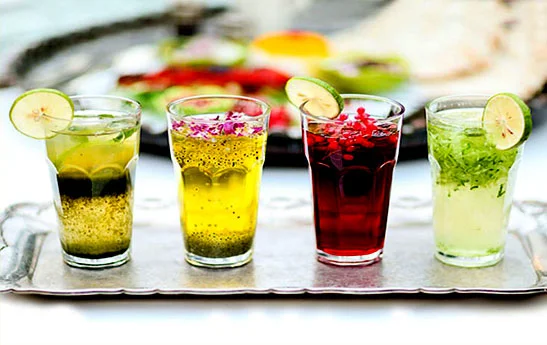10 Irresistible Spring Drinks You Can’t Miss!
Spring is a season of renewal, bursting with color, fragrance, and fresh ingredients. It’s the perfect time to enjoy a variety of spring drinks that refresh the body and awaken the senses. With an abundance of vibrant fruits, cooling herbs, and floral elements, spring offers the ideal canvas for crafting seasonal beverages. In this article, we’ll explore 10 delightful spring drinks—from traditional Persian syrups to fruity smoothies—each capturing the true spirit of spring. Whether you’re planning a picnic or just need a rejuvenating pick-me-up, these spring drinks are sure to brighten your day.

Table of Contents
Toggle🍹 1. Saffron Khakshir Syrup – A Persian Gem Among Spring Drinks
Servings: 6
One of the most refreshing spring drinks with roots in Persian tradition, Saffron Khakshir Syrup is both soothing and invigorating. Known for its cooling properties, this drink features khakshir (flaxseed), rosewater, and saffron—making it a flavorful and aromatic way to celebrate spring’s arrival.
Ingredients:
6 cups cold water
½ cup khakshir (flaxseed)
1 cup sugar
2 tablespoons rosewater
1 tablespoon brewed saffron
Instructions:
Soak khakshir in water for 5-10 minutes, then rinse thoroughly.
In a saucepan, combine 2-3 cups of water with sugar over low heat, stirring until sugar dissolves.
Bring to a gentle boil, then add rosewater.
At 5 minutes, add the washed khakshir and saffron brew.
Remove from heat and let it cool.
Serve by mixing 2 tablespoons of syrup with cold water and ice.
🌿 2. Orange Blossom & Mint Drink– A Floral and Herbal Spring Delight
Servings: 2
Ingredients:
3 tablespoons orange blossom water
2 tablespoons mint extract
2 tablespoons sugar
1 cup water
4 ice cubes
Instructions:
Mix water, sugar, and ice until the ice is crushed.
Mix in orange blossom water and peppermint extract, stirring until combined.
- Refrigerate and serve, topped with fresh mint leaves.
🍓 3. Apple & Strawberry Smoothie-A Refreshing Pick from Spring Drinks
Servings: 2
Ingredients:
2 cups strawberries
1 apple
⅔ cup non-fat yogurt
1 tablespoon honey
2 tablespoons cold water
Ice cubes
Instructions:
Wash and chop strawberries and apple, and remove the core.
Blend apple with water until smooth.
Add strawberries and honey, blending for 30 seconds.
Add yogurt and blend until creamy.
Pour over ice and serve.

🍍 4. Hawaiian Fruit Juice-A Tropical Treat from Spring Drinks
Servings: 2
Ingredients:
1 small banana
2 slices pineapple (fresh or canned)
1 small bowl of chopped mango
1 cup milk
2 ice cubes
2 tablespoons strawberry syrup
Colored sprinkles (optional)
Instructions:
Mix banana, pineapple, mango, strawberry syrup, milk, and ice until smooth.
Serve in tall glasses and garnish with fruit pieces and sprinkles.
🍋 5. Homemade Lemonade– A Zesty Classic in Spring Drinks
Servings: 4
Ingredients:
1 cup water
9 lemons
1 tablespoon lemon zest
1 cup sugar
Sparkling water
Instructions:
Wash lemons and zest one tablespoon of peel, avoiding the white pith.
Juice the lemons.
Combine water, sugar, and lemon zest in a saucepan over low heat until sugar dissolves.
Strain the mixture to remove zest.
Add lemon juice to the syrup.
Serve over ice, topping with sparkling water.
🌼 6. Saffron and Willow Water Syrup– A Calming Choice in Spring Drinks
Servings: 6
Ingredients:
4 cups sugar
1 cup water
2 cups willow water (Bidmeshk extract)
1 tablespoon chia seeds (Tukhm Sharbati)
1 tablespoon brewed saffron (optional but recommended)
Instructions:
Combine the sugar and water in a saucepan. Heat slowly until the sugar dissolves.
As the syrup thickens, wash the chia seeds and soak them in warm water to enable them to bloom.
Mix brewed saffron into the thickened syrup and stir gently to allow it to infuse its color and fragrance.
Once done, let the syrup cool slightly, then add the willow water.
Stir in the soaked chia seeds and mix well.
Store in the refrigerator. To serve, pour 2 tablespoons of syrup into a glass, add cold water and a few ice cubes. Stir and enjoy.
Tip: Not only is this scented syrup delicious to taste but also naturally calming since Bidmeshk and saffron have a sedative action. It’s a soothing gem among spring drinks.

🥕 7. Strawberry and Carrot Smoothie – A Nutrient-Packed Addition to Spring Drinks
Servings: 2
Ingredients:
2 medium carrots, peeled and chopped
1 cup strawberries (fresh or frozen)
1 to 1.5 cups fresh orange juice
1 cup crushed ice
Instructions:
Chop and thoroughly wash the strawberries and carrots.
Blend them together until smooth.
Add orange juice in portions while blending to reach the desired consistency.
Add crushed ice and blend again until the smoothie is chilled and smooth.
Serve in a tall glass with a straw, and enjoy this vitamin-rich spring booster.
Tip: Add a few mint leaves or a dash of cinnamon for extra depth of flavor.
🍹 8. Tea Punch with Fresh Citrus and Herbs-A Zesty Spark in Spring Drinks
Servings: 6–8
Ingredients:
900 ml black tea, brewed and chilled
½ cup granulated sugar
¼ cup chopped fresh basil
1 chopped lime
1 chopped orange
900 ml sparkling water
Ice cubes
Optional: cinnamon stick, basil and citrus for garnish
Instructions:
Steep the strong black tea and let it cool off completely.
In a large pitcher, combine the tea, sugar, orange and lime, chopped, and basil.
Add a cinnamon stick, if desired, for an added spice flavor note.
Cover and refrigerate for at least 4 hours, preferably overnight, for full flavor infusion.
Before serving, strain the mixture to remove solids, and stir in the sparkling water.
Pour over ice in glasses and garnish with basil leaves or citrus wedges.
Tip: This punch is perfect for spring parties and brings an energizing twist thanks to its mild caffeine content.
🍈 9. Cantaloupe and Ginger Refresher– A Spicy-Sweet Star in Spring Drinks
Servings: 3–4
Ingredients:
1 cantaloupe (~800 grams), peeled and deseeded
1 teaspoon ground ginger
6 tablespoons fruit-flavored syrup (optional)
3 tablespoons lemon juice
1 lime, sliced
Ice cubes
Instructions:
Roughly chop the cantaloupe flesh and place in a blender.
Add lemon juice, ground ginger, and syrup.
Blend at high speed until smooth.
Fill serving glasses with ice cubes and pour the blended mixture over them.
Garnish with lime slices and serve immediately.
Tip: Skip the syrup for a healthier version, or swap it with honey or date syrup for a natural sweetener. This refreshing mix is a must-try addition to your spring drinks lineup.

🍉 10. Watermelon Kiwi and Banana Smoothie-A Fruity Finale to Your Spring Drinks
Servings: 2
Ingredients:
1 cup diced watermelon (seedless)
1 kiwi, peeled and chopped
1 banana, sliced
Extra fruit slices for garnish (optional)
Instructions:
Slice and freeze all fruits ahead of time for a slushy texture.
Place frozen watermelon, kiwi, and banana in a blender and mix until silky smooth.
Pour into tall glasses and garnish with fresh kiwi or watermelon wedges.
Serve chilled, and refresh your body and mind on a warm spring afternoon.
Tip: For added texture, blend in 1 tablespoon of soaked chia seeds or flaxseed for an energy boost. A colorful and nutrient-rich pick from your spring drinks collection.
Tips for Making the Best Spring Drinks
Always use fresh, seasonal fruits for the best flavor and nutritional value.
Chill your serving glasses beforehand to keep your drinks cool longer.
To enhance aroma, use fresh herbs like mint or basil.
For a fizzy touch, swap still water with soda or sparkling mineral water.
Sweeten naturally with honey or fruit syrups to avoid refined sugars
1. Can I replace sugar with honey or a sugar substitute in these recipes?
Yes, honey and other natural sweeteners like agave syrup or stevia are great alternatives. Adjust the quantity to taste.
2. How long can I store homemade syrups?
Homemade syrups can be stored in the refrigerator in airtight containers for up to a week. Always check for any signs of spoilage.
3. Can I make these drinks vegan?
Most of these drinks are naturally vegan. For smoothies that include yogurt or milk, simply use plant-based alternatives like almond milk or coconut yogurt.
